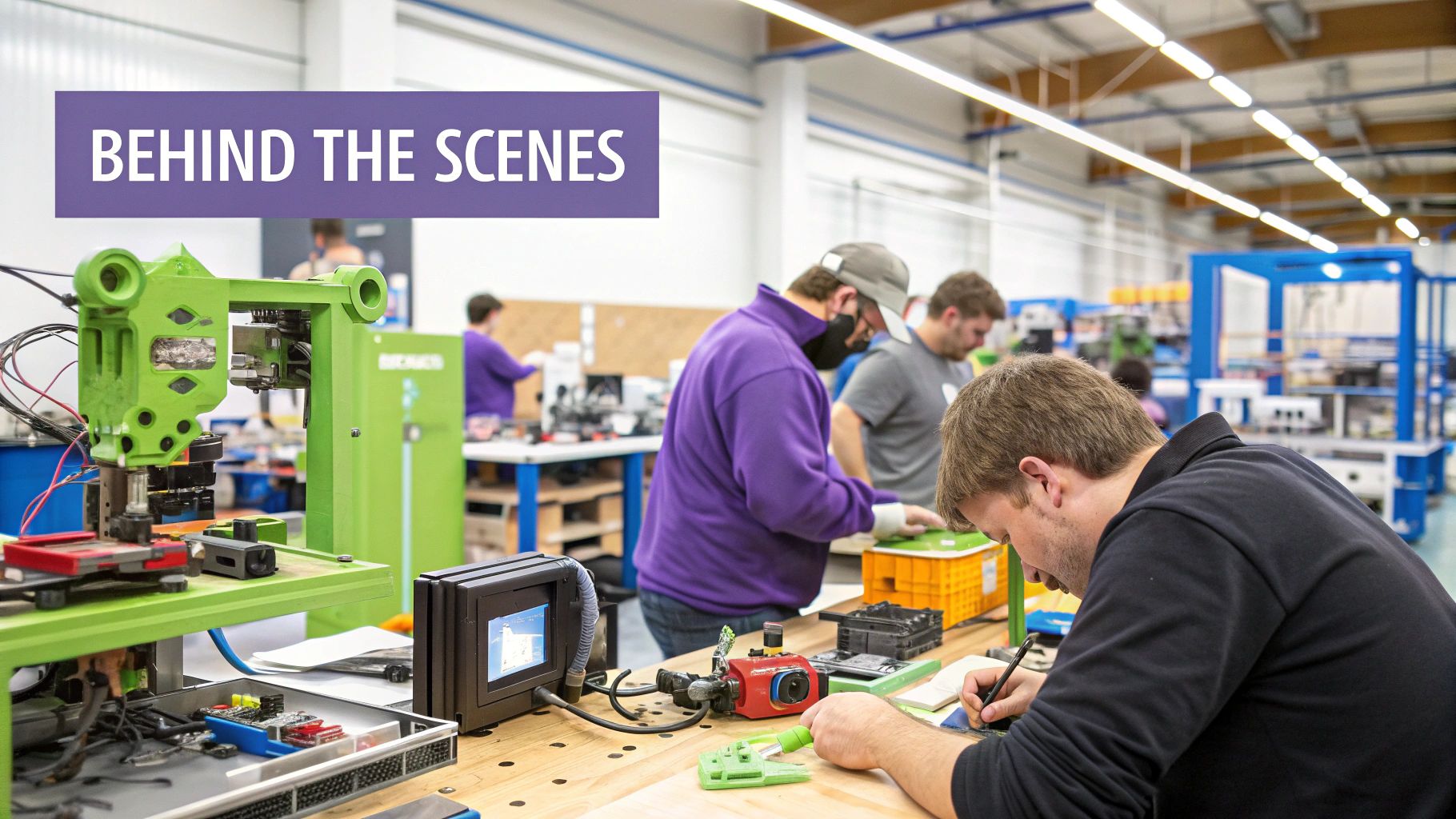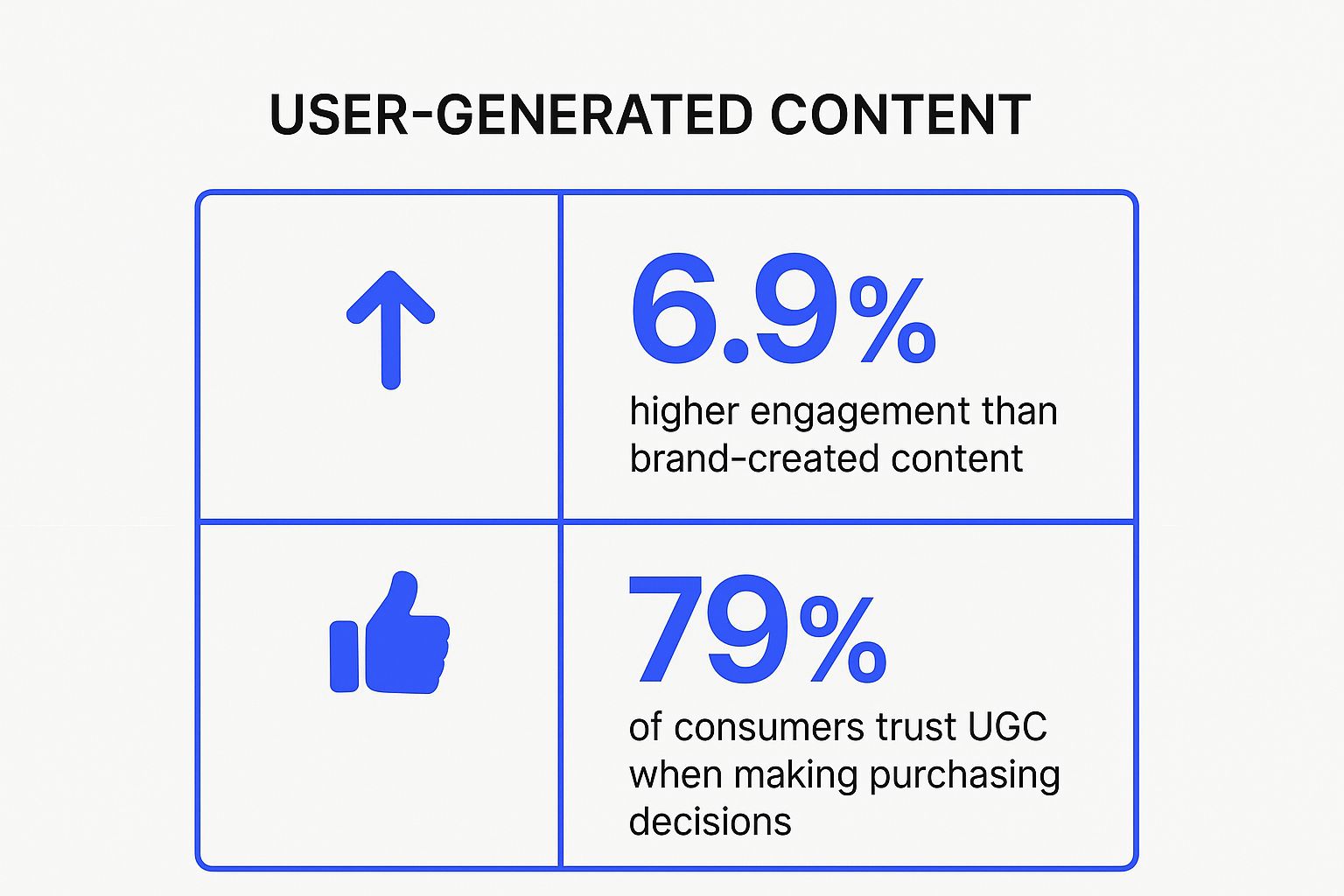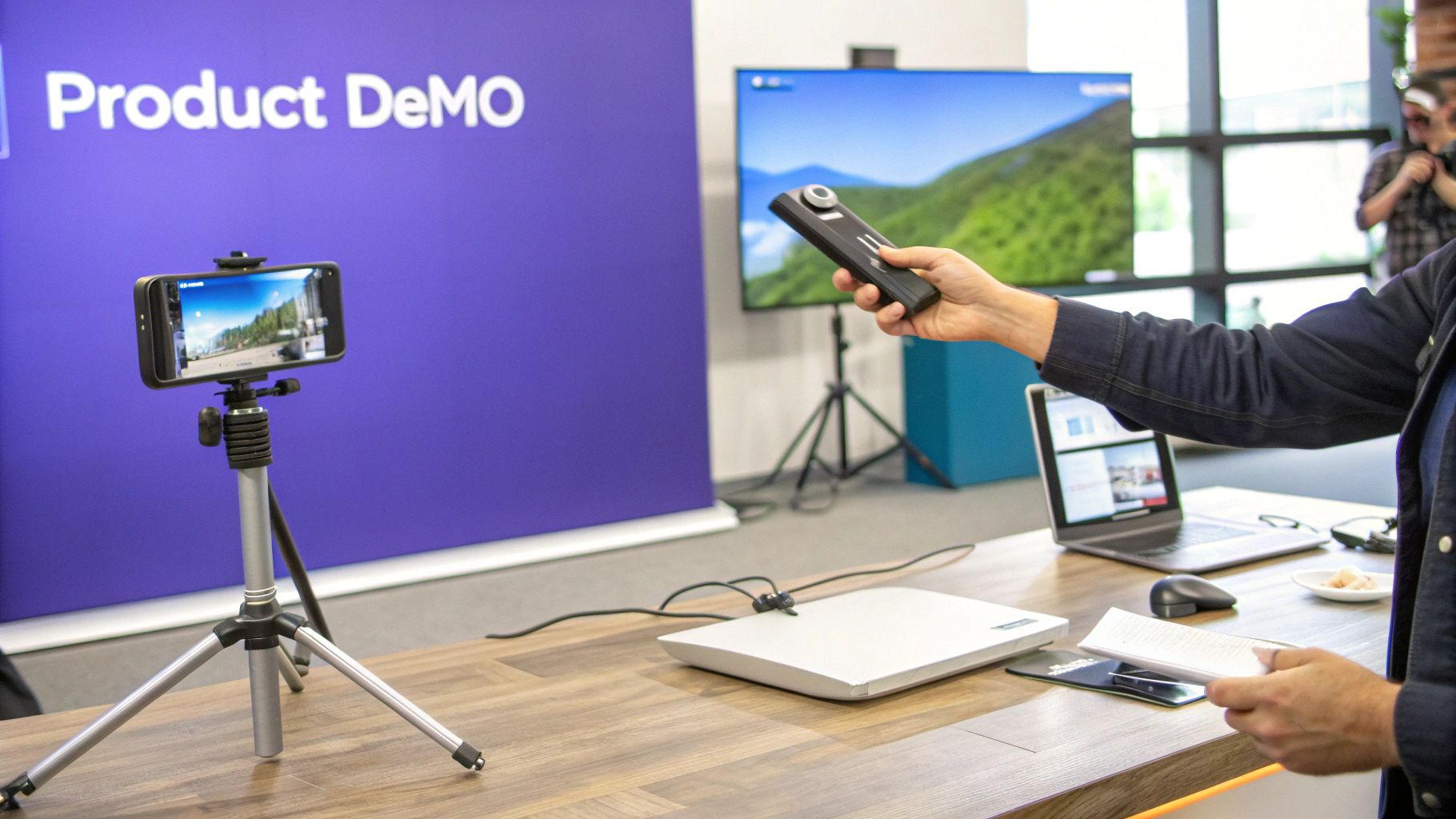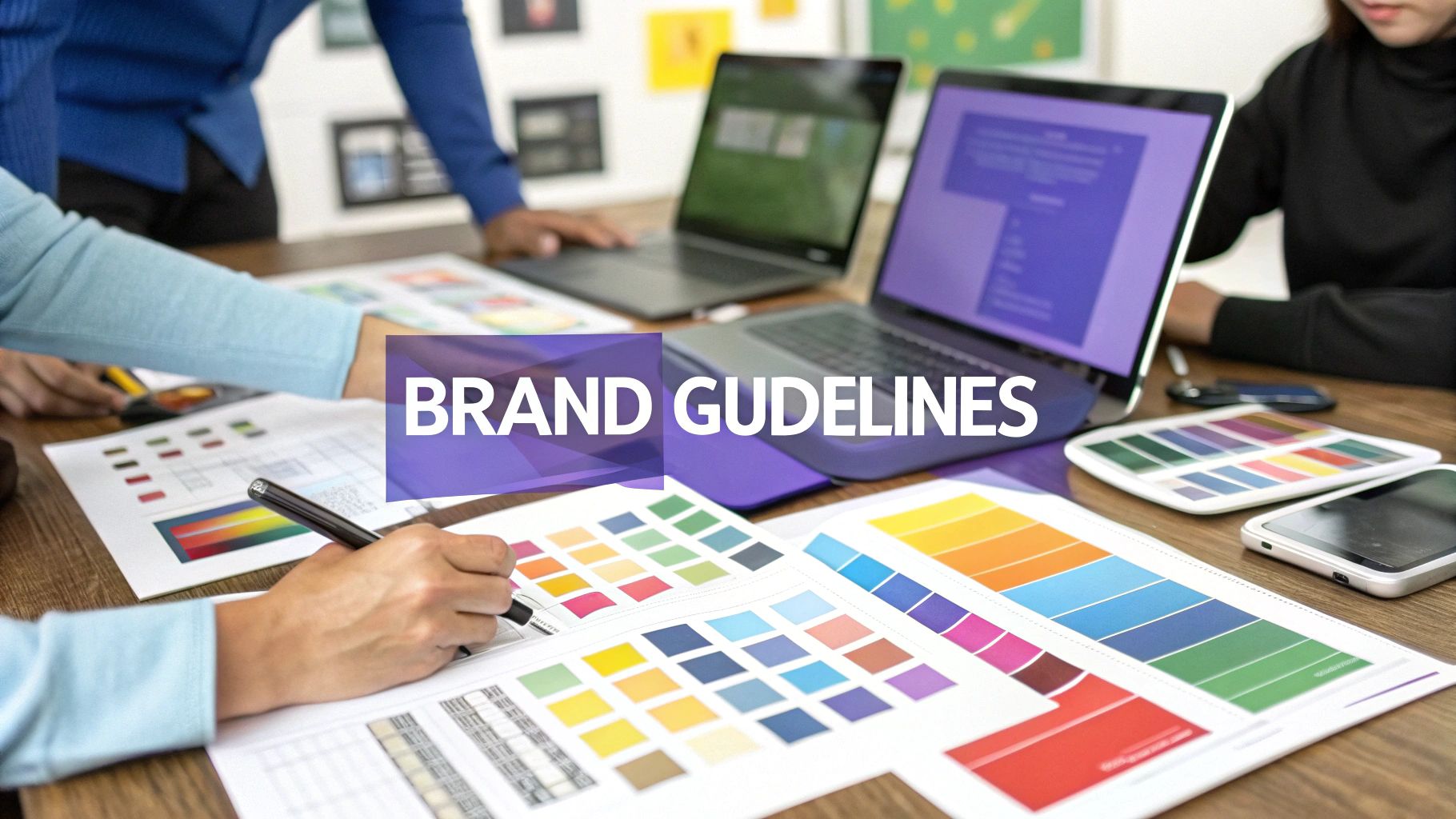Why Your Social Media Strategy Needs a Content Refresh
In a crowded digital feed, generic content no longer captures attention, fosters community, or drives growth. Sticking to the same old post formats leads to audience fatigue and stagnant metrics. The key to breaking through is a dynamic content strategy built on fresh, engaging ideas. If your engagement rates are flat or your follower count has stalled, it's time for a strategic refresh.
This guide moves beyond the basics, offering 10 powerful and proven social media content ideas designed to re-energize your profiles. We'll provide actionable strategies for various formats, from authentic behind-the-scenes glimpses to community-building interactive posts. To truly invigorate your presence, a deep dive into platform-specific content is essential. You can find more information on Facebook and Instagram content strategies to complement these broader concepts.
Whether you're a brand, creator, or agency, this list will equip you with the tools to create content that resonates deeply and delivers tangible results. Get ready to explore unique angles that will help you build a more loyal, engaged, and responsive following. Let’s dive into the ideas that will make your brand stand out.
1. Behind-the-Scenes Content
Behind-the-scenes (BTS) content is one of the most effective social media content ideas for building trust and humanizing your brand. It pulls back the curtain, offering your audience a genuine, unpolished look at the people, processes, and passion that fuel your work. This transparency fosters a deeper connection by showing the real effort and personality behind the finished product or service, moving your brand from a faceless entity to a relatable group of people.

This approach thrives on authenticity. Think of Gary Vaynerchuk's vlogs documenting his daily grind or how Glossier shares glimpses of its product development on Instagram Stories. These examples demonstrate that BTS content isn't about high-production value; it's about sharing authentic moments. You can showcase a "day in the life" of an employee, the meticulous process of crafting a product, or even the collaborative chaos of a brainstorming session.
How to Implement Behind-the-Scenes Content
To make this strategy work, focus on authenticity over perfection. Use your smartphone to capture spontaneous moments, as raw, minimally edited footage often performs best.
- Showcase Your Process: Film the journey of a product from concept to creation. A bakery could show the early morning dough-making process, while a software company could share a screen recording of a coding session.
- Introduce Your Team: Feature short interviews with team members, asking them about their roles or what they love about their job. This adds a personal touch and highlights your company culture.
- Share Both Wins and Fails: Don't just show the successes. Documenting a challenge and how you overcame it makes your brand more relatable and trustworthy.
- Utilize Live Video: Platforms like Instagram and Facebook Live are perfect for unscripted BTS moments, such as live Q&A sessions from your office or workshop tours.
2. User-Generated Content (UGC)
User-Generated Content (UGC) is a powerful social media content idea that transforms your audience into authentic brand advocates. It involves curating and sharing content created by your customers, fans, and followers, such as photos, videos, or reviews featuring your products or services. This strategy builds social proof and trust by showcasing real people enjoying your brand, which often resonates more deeply with potential customers than polished, brand-created advertising.
This infographic highlights key statistics that underscore the effectiveness of User-Generated Content.

The data clearly shows that UGC not only drives significantly higher engagement but is also a critical factor in consumer purchasing decisions. Brands like GoPro, which fills its feed with thrilling customer adventure videos, and Starbucks, with its famous #RedCupContest, have built entire communities around this concept. By featuring customer content, you validate their loyalty and provide an authentic, third-party endorsement that is invaluable for building credibility.
How to Implement User-Generated Content
Success with UGC hinges on creating a community feel and making it easy for users to participate. Always prioritize giving credit to the original creator.
- Create a Branded Hashtag: Launch a campaign with a simple, memorable hashtag (e.g., #ShareACoke) to easily track and collect submissions across platforms.
- Always Ask for Permission: Before reposting any content, reach out to the creator for their explicit permission. This respects their ownership and builds goodwill.
- Offer Incentives and Recognition: Encourage participation by offering rewards, such as a feature on your page, a discount, or entry into a contest. Publicly thanking creators fosters a positive community.
- Set Clear Guidelines: Provide simple rules for submissions to ensure the content aligns with your brand values and is appropriate for your audience.
3. Educational and How-To Content
Educational content is a cornerstone of any effective social media presence, positioning your brand as a helpful expert and trusted resource. Instead of directly selling, you provide tangible value by teaching your audience something new, solving a problem, or offering step-by-step instructions. This approach builds authority and goodwill, making followers more likely to turn to you when they are ready to make a purchase.
This strategy is about empowerment. Think of how HubSpot’s marketing tutorials demystify complex topics or how Canva’s design guides on Instagram empower non-designers to create beautiful visuals. These brands offer powerful social media content ideas that serve their audience first. The goal is to become the go-to source in your niche by consistently sharing valuable knowledge that addresses your audience's most pressing pain points and questions.
How to Implement Educational and How-To Content
Success with educational content hinges on clarity and utility. Your goal is to simplify complex information and make it immediately actionable for your audience.
- Break Down Complex Topics: Create carousels, short videos, or blog posts that break down a difficult subject into digestible, easy-to-follow steps. A finance company could explain compound interest with a simple visual series.
- Address Common Pain Points: Use your customer service inquiries or social media comments to identify common struggles. Create content that directly answers these questions, such as a quick tutorial video or a helpful checklist.
- Use Strong Visuals: Utilize infographics, screen recordings, and demonstrations to show, not just tell. A software brand can use a quick screen-capture video to demonstrate a new feature.
- Create Downloadable Resources: Offer free templates, checklists, or eBooks in exchange for an email address. This provides immense value while also helping you build your email list. These tutorials are a key part of any strong social media content strategy.
4. Interactive Content (Polls, Q&As, Quizzes)
Interactive content transforms passive scrolling into active participation, making it one of the most powerful social media content ideas for boosting engagement. By inviting your audience to share opinions through polls, answer questions in Q&As, or test their knowledge with quizzes, you create a dynamic two-way conversation. This direct interaction not only increases visibility through platform algorithms but also provides invaluable insights into your audience's preferences, pain points, and desires, fostering a strong sense of community.
This strategy is about making your audience the star of the show. Think of how Netflix uses Twitter polls to let fans debate character fates or how BuzzFeed built an empire on personality quizzes that people are eager to share. These formats work because they are inherently personal and shareable. You can use an Instagram Story poll to help decide on a new product color, host a live Q&A with an expert on Facebook, or run a LinkedIn poll to gather professional opinions on an industry trend.
How to Implement Interactive Content
Success with interactive content depends on making participation easy, fun, and rewarding. Frame your questions to be engaging and relevant to your audience's interests.
- Ask Meaningful Questions: Use polls and Q&As to conduct light market research. Ask about product preferences, content desires, or challenges they face. For example, a fitness brand could ask, "What's your biggest workout struggle: motivation or time?"
- Run Engaging Quizzes: Create quizzes that are either educational ("Test Your Industry Knowledge") or entertaining ("Which of Our Products Matches Your Personality?"). Use tools like Typeform or Jotform and link them in your bio.
- Leverage Platform Features: Make full use of built-in tools like Instagram's question, poll, and quiz stickers, Twitter Polls, and LinkedIn Polls. These are simple for users to engage with directly in their feed.
- Share and Act on the Results: Always follow up by sharing the results of a poll or a summary of Q&A responses. This closes the loop and shows your audience that their input is valued and heard.
5. Trending Topics and Current Events
Leveraging trending topics is a powerful social media content idea that involves tapping into current events, viral challenges, and pop culture moments. This strategy, often called trendjacking, helps your brand join larger, ongoing conversations, dramatically increasing your visibility and relevance. By aligning your content with what's already capturing attention, you can engage with a much broader audience beyond your existing followers and demonstrate that your brand is current and culturally aware.

The key is to act fast while maintaining brand integrity. Think of Oreo's legendary "You can still dunk in the dark" tweet during the 2013 Super Bowl blackout or how brands like Wendy's and MoonPie masterfully participate in internet memes. These examples show that reacting quickly with a clever, brand-aligned take can produce massive organic reach. The goal is not just to repeat the trend but to add a unique, valuable, or humorous perspective that resonates with your specific audience.
How to Implement Trending Topics and Current Events
Success with this strategy requires speed, creativity, and a clear understanding of your brand voice. You'll need to monitor what's happening and have a streamlined approval process to respond quickly.
- Act Quickly and Decisively: Trends have a short lifespan. Monitor platforms like X (formerly Twitter), TikTok, and Google Trends to spot opportunities and be prepared to create and post content within hours.
- Ensure Brand Alignment: Before jumping on a trend, ask if it aligns with your brand's values and voice. A forced or off-brand attempt can backfire and appear inauthentic to your audience.
- Add a Unique Perspective: Don't just repost a meme. Connect the trend back to your product, service, or industry in a clever way. Add humor, insight, or a unique spin that provides value.
- Plan Ahead When Possible: While many trends are spontaneous, some events like holidays, awards shows, or sports finals are predictable. Use a social media calendar to prepare for these moments. You can learn more about how to create one with this social media calendar template.
6. Storytelling and Personal Narratives
Storytelling and personal narratives are powerful social media content ideas that forge deep emotional connections with your audience. Instead of simply listing facts or features, this strategy weaves a narrative around your brand, values, or customers. It transforms information into a memorable experience that resonates on a human level, making your message stickier and more impactful. A well-told story can build loyalty and differentiate you in a crowded marketplace.
This approach is about creating a compelling plot with characters, challenges, and resolutions. Think of how Humans of New York shares deeply personal stories that captivate millions, or how Patagonia uses narratives of environmental activism to reinforce its brand mission. These examples show that great stories aren't just for entertainment; they are a vehicle for sharing values, building community, and driving action. Your brand’s origin, a customer's success, or an employee's journey can all be powerful narrative assets.
How to Implement Storytelling and Personal Narratives
To succeed with storytelling, focus on creating an authentic narrative arc that elicits emotion and connects back to your brand’s core purpose.
- Structure Your Narrative: Every good story has a beginning, a middle, and an end. Introduce a character (your brand, a customer), present a conflict or challenge they faced, and show the resolution or transformation.
- Focus on Authentic Voices: Feature real people and their genuine experiences. Use direct quotes, user-generated content, or first-person accounts to make the story feel personal and credible.
- Highlight Relatable Challenges: Share stories of overcoming obstacles. A narrative about a struggle and subsequent triumph is far more engaging and inspiring than one that only showcases success.
- Connect Stories to Your Brand Message: Ensure each story subtly reinforces your brand's values or mission. The narrative should serve as proof of what your brand stands for without feeling like a direct advertisement.
7. Product Showcases and Demonstrations
Product showcases and demonstrations are powerful social media content ideas that move beyond simple advertising to educate and engage potential customers. This content highlights your product's features, benefits, and real-world applications, directly supporting sales objectives by showing, not just telling. By demonstrating how your product solves a problem or enhances a user's life, you provide tangible value and build buyer confidence, making it a crucial tool for any product-based business.

This strategy is about bridging the gap between a product and its potential user. Think of tech reviewer MKBHD's detailed video breakdowns of new gadgets or how Home Depot uses short videos to demonstrate DIY projects. These examples succeed because they focus on the user's perspective, answering questions and showing the product in a realistic context. You can create content ranging from a quick unboxing video to an in-depth tutorial or a feature-specific demonstration that addresses a common pain point.
How to Implement Product Showcases and Demonstrations
To create effective showcases, prioritize demonstrating value over delivering a hard sell. Your goal is to help the audience envision themselves using and benefiting from the product.
- Focus on Solving Problems: Frame your demonstration around a common customer challenge. A cookware brand could show how its non-stick pan makes cleanup effortless, directly addressing a pain point.
- Show Products in Real-Life Contexts: Instead of a sterile studio shot, show your product in action. A clothing brand can feature models wearing the apparel in everyday situations, helping customers visualize the fit and style.
- Highlight Unique Features: Isolate a specific feature that sets your product apart and create a short video or carousel post dedicated to it. Tesla often does this with features like Autopilot or Sentry Mode.
- Create How-To Guides and Tutorials: Develop step-by-step content that teaches your audience how to get the most out of your product. This is a hallmark of brands like Sephora, which uses makeup tutorials to feature and sell specific items.
8. Community-Driven Content
Community-driven content is a powerful strategy that shifts the focus from brand-centric promotion to fostering a thriving ecosystem around your audience. Instead of just broadcasting messages, you create a space where customers can connect, share experiences, and support one another, with your brand acting as the facilitator. This approach builds immense loyalty and transforms customers into passionate advocates who generate authentic content on your behalf.
This method is about building belonging. Think of how Peloton creates fitness challenges that unite members or how Sephora's Beauty Insider Community allows makeup enthusiasts to share tips and product reviews. The value comes from member-to-member interaction, not just brand-to-customer communication. These communities provide invaluable social proof and user-generated content, making them one of the most sustainable social media content ideas for long-term engagement.
How to Implement Community-Driven Content
Success here depends on empowerment and genuine interaction. Your primary goal is to facilitate connections and celebrate your members, not just sell to them.
- Celebrate Your Members: Regularly spotlight community members by sharing their posts, stories, or achievements. A simple "Member of the Week" feature can make individuals feel seen and valued.
- Create Exclusive Spaces: Use platforms like Facebook Groups, Discord servers, or dedicated forums to create a private, exclusive hub for your most loyal followers. Offer them early access or exclusive content.
- Facilitate Connections: Pose open-ended questions, run community-wide challenges, or create threads that encourage members to interact with each other, not just with your brand page.
- Establish Clear Guidelines: To ensure a safe and positive environment, create and enforce clear community rules. This protects the space and encourages respectful participation from everyone.
9. Visual Content (Infographics, Memes, Graphics)
Visual content is a cornerstone of engaging social media content ideas, prioritizing compelling imagery and design to communicate messages quickly. This content type leverages the power of visual communication to capture attention in crowded feeds, simplify complex information, and create highly shareable assets that perform exceptionally well across all platforms. From data-rich infographics to humorous memes, visuals make your message more digestible and memorable.
This strategy is about more than just pretty pictures; it’s about strategic communication. Think of how Canva uses its own platform to create stunning design tip graphics, how HubSpot breaks down marketing data into easy-to-read infographics, or how Netflix uses memes to connect with its audience culturally. These examples show how visuals can educate, entertain, and build brand identity simultaneously. While diverse graphics are key, don't forget the power of a professional image for your brand representatives; a great headshot can anchor your brand's human element on platforms like LinkedIn, and this guide to stunning professional portraits can help you capture the perfect one.
How to Implement Visual Content
To succeed with visual content, you must balance aesthetics with clear messaging and brand consistency. It’s about creating visuals that not only look good but also serve a purpose.
- Create Branded Templates: Use tools like Canva or Adobe Express to design templates for quotes, tips, and announcements. This ensures a cohesive visual identity across all your posts.
- Simplify Complex Data with Infographics: Turn statistics, research findings, or step-by-step processes into compelling infographics. This makes dense information easy to understand and share.
- Tap into Meme Culture (Carefully): Use relevant, timely memes to showcase your brand's personality and connect with a younger audience. Ensure the meme format aligns with your brand's tone of voice.
- Prioritize High-Quality Imagery: Invest in high-quality stock photos, or better yet, original photography. High-resolution, well-composed images make your brand look more professional and trustworthy.
10. Live Content and Real-Time Engagement
Live content is a powerful social media content idea that fosters immediate, unfiltered connections with your audience. Broadcasting in real-time through streams, webinars, or Q&A sessions creates a sense of urgency and exclusivity, making viewers feel like they are part of a unique event. This format excels at building community and trust by offering direct, authentic interaction, transforming passive followers into an engaged community.
The unscripted nature of live video is its greatest strength. Think of popular Twitch streamers who build massive communities through interactive gaming sessions, or LinkedIn influencers hosting live talks on industry trends. These examples show that live content thrives on spontaneous engagement and two-way conversation. The value lies not in polished production but in the raw, real-time connection you build with your viewers, moment by moment.
How to Implement Live Content and Real-Time Engagement
Success with live content hinges on preparation and active participation. While the broadcast is live, much of the work happens before and after the stream.
- Promote Your Session: Announce your live event at least a few days in advance across all your social channels. Use countdown stickers on Instagram Stories or create event pages on Facebook and LinkedIn to build anticipation.
- Plan Key Talking Points: While you should remain conversational, having a loose outline of topics ensures the session stays on track and delivers value. Don't write a full script, just key points to guide the conversation.
- Engage with Your Audience: Actively monitor and respond to comments during the broadcast. Address viewers by name and answer their questions to make them feel seen and heard. This interaction is the core of live engagement.
- Save and Repurpose: Always save your live video. You can repurpose the full recording for YouTube or snip the best moments into short clips for Reels, Shorts, or TikTok. This extends the life of your content far beyond the live broadcast.
Top 10 Social Media Content Ideas Comparison
| Content Type | Implementation Complexity 🔄 | Resource Requirements ⚡ | Expected Outcomes 📊 | Ideal Use Cases 💡 | Key Advantages ⭐ |
|---|---|---|---|---|---|
| Behind-the-Scenes Content | Medium - requires consistent creation and planning | Low - cost-effective with minimal editing | Builds trust, authenticity, emotional connection | Brand humanization, culture showcasing | Authenticity, relatability, cost-effective |
| User-Generated Content (UGC) | Low to Medium - coordinating and legal checks | Low - content sourced from users | High trust, increased engagement, social proof | Community building, social proof campaigns | Highly authentic, cost-saving, boosts loyalty |
| Educational and How-To Content | High - needs research and quality production | Medium to High - time and expertise intensive | Establishes authority, long-term value | Tutorials, thought leadership, problem solving | Builds expertise, shareable, improves SEO |
| Interactive Content (Polls, Q&As, Quizzes) | Medium - requires active management | Low to Medium - depends on tech and monitoring | Significantly boosts engagement, collects data | Engagement boosting, audience insights | High engagement, feedback loops, gamification |
| Trending Topics and Current Events | High - demands quick adaptation and monitoring | Low to Medium - time-sensitive content creation | Potential virality, increased discoverability | Timely marketing, viral campaigns | Viral potential, relevance, cost-effective exposure |
| Storytelling and Personal Narratives | High - skill-intensive, time-consuming | Medium - strong writing or production skills | Creates emotional bonds, memorable engagement | Brand storytelling, emotional marketing | Emotional connection, memorable, trust building |
| Product Showcases and Demonstrations | Medium to High - quality production required | Medium to High - polished visuals and demos | Drives sales, informs purchase decisions | Sales support, product launches | Conversion-driven, confidence building |
| Community-Driven Content | High - requires ongoing moderation and facilitation | Medium - community management resources | Builds loyalty, self-sustaining engagement | Building brand communities, advocacy | High retention, authentic engagement |
| Visual Content (Infographics, Memes, Graphics) | Medium - needs design skills/resources | Medium - creative and design tools | High shareability, quick message absorption | Brand awareness, complex info simplification | Highly shareable, strong branding, visual appeal |
| Live Content and Real-Time Engagement | High - needs confident presentation and tech setup | Medium - streaming tools and stable connection | Strong personal connection, instant engagement | Real-time Q&A, launches, events | Authenticity, high engagement, immediate feedback |
Turn Your Ideas into a High-Performing Content Calendar
You've just explored a comprehensive toolkit of powerful social media content ideas, from giving your audience an exclusive look behind the scenes to harnessing the authentic power of user-generated content. We’ve covered the strategic value of educational how-tos, the engagement-boosting magic of interactive polls, and the community-building force of storytelling. The key takeaway is clear: a successful social media strategy is not about finding one perfect type of content. It’s about building a dynamic and varied mix that keeps your audience engaged, informed, and connected to your brand.
The real challenge isn't a lack of ideas; it's transforming this creative potential into a consistent, high-performing content stream. An endless scroll of possibilities can feel overwhelming without a structured approach. The goal is to move from "what could we post?" to "what should we post, when, and why?" This transition from ideation to execution is where many strategies either flourish or fail.
From Inspiration to Implementation
To truly leverage the concepts we've discussed, you must organize them into a cohesive content calendar. A well-planned calendar ensures you’re not just posting randomly but are strategically balancing different content pillars to achieve specific goals. For example, you might schedule:
- Mondays: Educational content to start the week with value.
- Wednesdays: Interactive Q&As or polls to drive midweek engagement.
- Fridays: Behind-the-scenes or user-generated content to build community and end the week on a high note.
- Throughout: Live sessions for major announcements and product showcases for new launches.
This structured approach guarantees a rich content diet for your followers, preventing fatigue and maintaining their interest. As you plan your calendar, you might find you need a fresh burst of inspiration. For more techniques on brainstorming, consider exploring these 10 innovative ways to spark creativity and generate ideas to keep your content pipeline full.
Build a System, Not Just a List
Ultimately, mastering your social media presence comes down to building a reliable system. By implementing these social media content ideas within a structured framework, you create a predictable yet dynamic engine for growth. You’ll be better equipped to connect with your audience, build a loyal community, and drive meaningful business results. The ideas are your fuel; a strategic content calendar is the vehicle that will take your brand where it needs to go.
Ready to turn these ideas into an actionable plan? A powerful social media management tool like PostSyncer can help you organize, schedule, and analyze your content across all platforms from a single, intuitive dashboard. Transform your creative sparks into a consistent, high-performing social media presence.
Start building a more dynamic and effective content strategy today with a free trial of PostSyncer.















